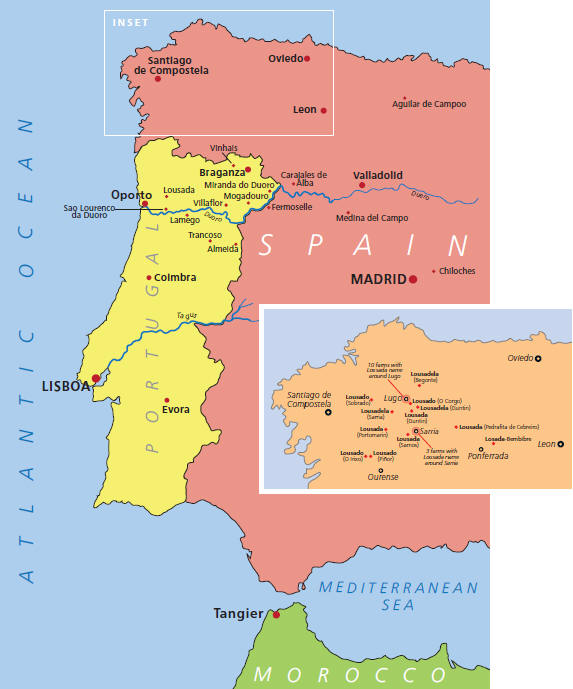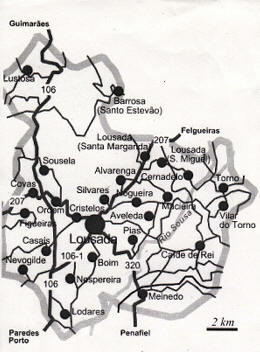

Map of relevant Iberian locations thanks to John Bury (see note 6 below for Tangier)
The Jewish population in Spain in 1492 was about 100,000 (ref 11) and of those who left Spain half went to Portugal (ref 193) so that by 1495 the Jewish population of Portugal increased from 3000 to 35000 (ref 193), which of course means 91% were from Spain. The forced baptisms of all Portuguese Jews in 1497 led to the suppression of Jewish names and the adoption of names judged to be Christian and Portuguese. Town-names were widely used in this context. Oporto is and was a significant trading city and had one of the major Jewish communities in Portugal in the 15th century exceeded only by Lisbon and Evora both in the south. Oporto was the birthplace in 1696 of Diego Lopes Pereira, later made Baron d'Aguilar in Vienna before returning to England where his daughter Judith married Isaac Baruh Lousada.
Communities existed at Guimaraes and Amarante which straddle the Portuguese Lousada villages which are a little north of the Duoro about 40 km from Lamego. This is a mediaeval cathedral city located about 65km upstream from Oporto but a few km to the south of the Duoro River. It is close to the Spanish border which is accessible along the Duoro River valley; Lamego once controlled freight along the Duoro and is now in an important agricultural and textile region. The Jewish population of Lamego increased significantly after the Spanish expulsion of 1492. The Portuguese Inquisition was slower to develop than the Spanish and for example it only acquired confiscation powers in 1579 (ref 179 p61), but Lamego had the dubious distinction of an early visitation in 1541. The Baruch Lousadas had 5 marriages with people bearing the 'Lamego' surname. The Portuguese Lousada places - the main town Lousada with its outlying villages of Lousada de Santa Margarida, and Lousada de San Miguel - are close together (see note 8 below). They are shown as one place on the map above, which also shows many Lousada placenames in Galicia, and some Losada placenames in Asturias and Leon - eg we have shown a Losada-Bembibre (see note 1 below). The spread of the same name across the border between Portugal and Galicia, with the equivalent name appearing across their borders with Castilian Spain, means that it is not easy to identify where our Lousada name came from (see also note 4 below). Villaflor, we have deduced, was the home for a cluster of families linked to the Baruch Lousadas (see note 7 below). Almeida is a name occurring in a Lousada marriage (see note 2 below).
Many Portuguese New Christians migrated back to Spain particularly in the 1580-1640 period of Spanish/Portuguese union (see note 3 below). Thus Fermoselle, Mogaduoro, Carbajales de Alba and Medina del Campo arise in the story of the Carvajals before they went to Mexico, only to suffer at the hands of the Mexican Inquisition in 1590 and 1596 (some survived - see note 5 below). Isaac Cardoso (ref 41) was born in Trancoso in 1604 to a family that had fled Spain but later returned. Cardoso is a common Portuguese name which was perhaps adopted to hide the family's origins. After becoming a physician (at the University of Valladolid and perhaps Salamanca) he became a celebrity at Court in Madrid before escaping (with great aplomb) the resurgence of anti-Semitism in Madrid in 1648 and settled in Venice then Verona where he became a noted writer of texts on science, medicine and Judaism. During his time in Madrid he successfully appeared in the defence of a Lamego relative who figured in the Olivares refinancing (see note 3 below) - Bartolome Febos - who was accused of Judaizing but who escaped lightly. The story of Genie Milgrom's ancestors from the Fermoselle/Mogadouro area (ref 130) includes Losados from Benavente (not shown but see note 5). Mogaduoro is also a source of Lopes Pereira (and hence Lousada) ancestors, as we record elsewhere. The Lousadas also married the Aguilars (see note 8 below).
Notes:
1. This name represents the hereditary Losada property near Bembibre of the Marquis of Valdecarzana, father of the Duque de Losada. The Miranda paternal surname of Spanish Duque de Losada appears in the town of Miranda do Duoro, but we have not traced this linkage. However 'Oviedo' appears in the name of the Duque's baptismal church. The Duque was not, we have concluded, closely related to the Baruch Lousadas.
2. Abigail Baruh Lousada #131 married an Almeida - she is known in our records as the widowed sister of Jacob #36 and Aaron #125 - and his name is variously (mis)spelled as Almoyde, Almeyde and Almeyda. One report puts the ancestral home of the Aguilars at Aguilar de Campoo in northern Spain. Simon Greenfield advised he could find no link between the Lopes Pereiras and the Aguilars. Another Lousada/Almeida marriage took place - see our discussion of Lousada names - but we have not established he was a Baruch Lousada though could have been part of a 3rd exit of Baruch Lousadas after the initial exit to Livorno and the exit of the Den Haag Louzadas to Amsterdam.
3. This period was very influential in the rise of the Portuguese New Christians, for the wealth some made from Atlantic (and wider) trading lead many of them to Madrid under Olivares who used their wealth for new Crown financing and then after Olivares many left enriched and this greatly strengthened the Sephardic Jewish community of Amsterdam. Chiloches was the location of the estates of Manuel Pinto e Ribero - a Jewish financier from Lisbon who, after he sold out of the financial asientos - syndicates which refinanced the Spanish Crown under d'Olivares in the period 1625-43 - retired there and concentrated on securing the nobility of his family in Madrid. Close relatives lived as Jews in Amsterdam.
4. There is no hypothesis linking all these names. Perhaps going back to early days of the Reconquista and the early de Losada nobility there were historic ownership links between, on the one hand, the Lousada places in Galicia and Portugal, and on the other hand, the Losada places in Asturias, Leon and Castile in northern Spain.
5. It is reported (ref 38) that the youngest survivor of them - Joseph Leon who escaped with 2 uncles around 1596 - married into the old Italian Montefiore family, which - reinvigorated! - went on to flourish in Livorno, England and later in Australia. James Greener advises us that Benavente was the birthplace of an uncle of Joseph Leon - Balthasar Rodriguez - who escaped the Mexican Inquisition around 1590 as discussed elsewhere.
6. Tangier in Morocco was part of the astonishingly splendid dowry that Catherine of Braganza brought to her marriage to Charles 2 of England in 1662 - not only was the marriage recommended in the first place by highly-placed Portuguese Jewish merchants, but they conducted the negotiation for the dowry. Tangier proved too difficult for the English to retain in the long run. The House of Braganza figured in the story of Jamaica in the period until the English 'conquest' of the island in 1655. The House of Braganza based itself in the south (near Evora) after 1501 at which time it departed its former ancestral home of Guimaraes a few kilometers from the Portuguese Lousada villages.
7. Abraham Isarel Pereira aka Tomas Rodrigues Pereira was born there in 1606 (ref 145). He probably had a Baruch Lousada mother (ref 141), whose family was probably located nearby. Abraham Israel Pereira was a cousin of Abraham Baruh Lousada #45 and therefore Moses Baruh Lousada and some details of him can be found on the Amsterdam and Madrid pages and from the latter we can see that he was (briefly) brother-in-law of Fernando Montezinos - a name linked with the Lousadas by marriage (ref 107), with Villaflor (since Antonio Montezinos aka Aaron Levi came from Villaflor) and with the Rodrigues Lamegos of Rouen (since he was their Madrid agent).
8. A local map (below) obtained in 2003 shows the 3 Lousada locations in the Porto region not far from Guimaraes. The House of Braganza until 1501 was based at Guimaraes near the Portuguese Lousada villages before relocating to Evora. The founder of Guimaraes was Vimara Peres whose statue is in Porto.
